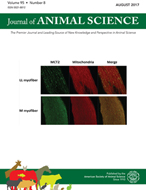-
Views
-
Cite
Cite
G. C. Márquez, S. E. Speidel, R. M. Enns, D. J. Garrick, Genetic diversity and population structure of American Red Angus cattle, Journal of Animal Science, Volume 88, Issue 1, January 2010, Pages 59–68, https://doi.org/10.2527/jas.2008-1292
Close - Share Icon Share
ABSTRACT
The objective of this study was to characterize the population structure and genetic diversity of registered American Red Angus cattle. Inbreeding and average relationship coefficients, effective population size, effective number of founders, and effective number of herds supplying grandparents to the population were calculated from the recorded pedigree. Inbreeding in 1960 was 10.7% and decreased until 1974 at a rate of 0.2% per year, whereas in 1975 inbreeding was 3.2% and increased until 2005 at a rate of 0.02% per year. The numerator relationship coefficients of the 10 individual paternal grandsires (PGS; sires of sires), paternal granddams (PGD; dams of sires), maternal grandsires (MGS; sires of dams), and maternal granddams (MGD; dams of dams) that had the greatest number of registered grandprogeny, with all other registered animals, increased with their birth year from 1960 on. Average numerator relationships of these with all other PGS, PGD, MGS, MGD, bulls, and sires were greater for paternal (PGS, PGD) than maternal (MGS, MGD) pathways. The effective population size was 445, with 649 effective founders. The effective numbers of herds supplying PGS, PGD, MGS, and MGD were 435, 369, 453, and 459, respectively. Inbreeding is at a low level and the effective population size is large. The effective number of founders and effective number of herds supplying grandparents is small in relation to the total number of animals and herds, indicating the disproportionate influence of a few founders and herds on the genetics of the breed. The calculated parameters indicate satisfactory genetic diversity in American Red Angus cattle.





